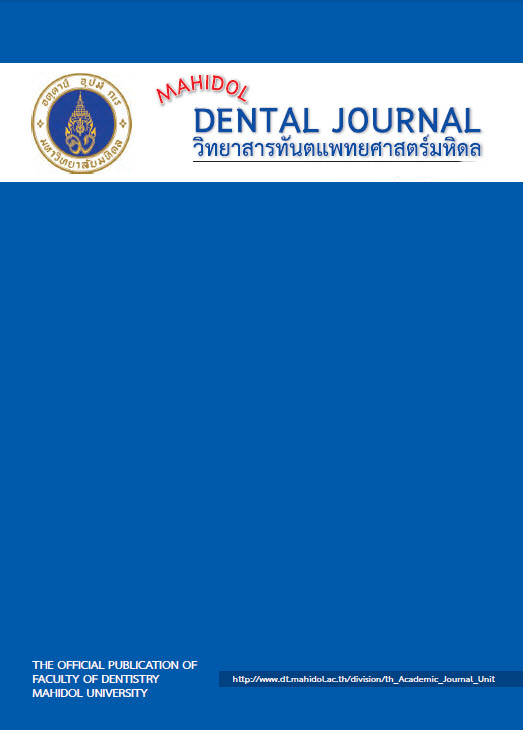A micro-computed tomography study of internal gap with and without resin-modified glass-ionomer cement liner under occlusal resin composite restoration
Main Article Content
Abstract
Objective: The aim of this in vitro study was to compare internal gaps between dentin and resin composite
restorations with and without lining with resin-modified glass-ionomer cement (RMGIC) by micro-computed
tomography (micro-CT).
Materials and methods: Twenty extracted human upper premolars without cracks, restoratives, or caries were collected and occlusal cavity was prepared on each tooth. Specimens were randomly divided into two groups (n=10). In Group G, specimens were lined with RMGIC (Vitrebond™ Light Cure Glass Ionomer Liner/Base, 3M ESPE, USA) for 0.5 mm and filled with the resin composite (A1, Filtek™ Z350 XT Universal Restorative, 3M ESPE, USA). In Group C, specimens were only filled with the resin composite (A1, Filtek™ Z350 XT Universal Restorative, 3M ESPE, USA). All two groups using Adper Single Bond 2 adhesive (3M ESPE, St Paul, MN, USA) before filled with resin composite. Specimens were scanned with micro-computed tomography (micro-CT) and bucco-palatal cut. Three images of each specimen were used to measure the size of internal gaps at bucco-pulpal and palato-pulpal surfaces, and gaps between the two filler materials were measured for group G.
Results: There was no gap formation between D-RMGIC; however, there were internal gaps between RMGIC-RC. In addition, the mean sizes of the internal gap between D-RC and RMGIC-RC were 29.850 ± 14.345 μm and 23.673 ± 11.182 μm, respectively. There was a significant difference in internal gap sizes between D-RMGIC and D-RC and between D-RMGIC and RMGIC-RC. However, the mean sizes of internal gaps between D-RMGIC and RMGIC-RC were not statistically different (p<0.05).
Conclusion: Lining with RMGIC at the pulpal floor of the cavity provided better adaptation than restoration with resin composites. In addition, internal gap appeared between RMGIC liner and resin composite was not
significantly different from internal gap between dentin and resin composite.
Article Details
References
Mitra SB, Wu D, Holmes BN. An application of nanotechnology in advanced dental materials. J Am Dent Assoc. 2003; 134: 1382-90.
Kleverlaan CJ, Feilzer AJ. Polymerization shrinkage and contraction stress of dental resin composites. Dent Mater. 2005; 21: 1150-7.
Bicalho AA, Valdívia AD, Barreto BC, Tantbirojn D, Versluis A, Soares CJ. Incremental filling technique and composite material--part II: shrinkage and shrinkage stresses. Oper Dent. 2014; 39: e83-92.
Soares CJ, Faria-E-Silva AL, Rodrigues MP, Vilela ABF, Pfeifer CS,
Tantbirojn D et al. Polymerization shrinkage stress of composite resins and resin cements - What do we need to know?. Braz Oral Res. 2017; 31: e62.
Bicalho AA, Pereira RD, Zanatta RF, Franco SD, Tantbirojn D, Versluis A, Soares CJ. Incremental filling technique and composite material--part I: cuspal deformation, bond strength, and physical properties. Oper Dent. 2014; 39: e71-82.
Sakaguchi R, Ferracane J, Powers J. Craig's restorative dental materials 14th edition. St Louis: Elsevier; 2019:128-130.
Giachetti L, Scaminaci RD, Bambi C, Grandini R. A review of polymerization shrinkage stress: current techniques for posterior direct resin restorations. J Contemp Dent Pract. 2006; 7: 79-88.
Dionysopoulos D, Koliniotou-Koumpia E. SEM evaluation of internal adaptation of bases and liners under composite restorations. Dent J. 2014; 2: 52-64.
Peliz MIL, Duarte S Jr, Dinelli W. Scanning electron microscope analysis of internal adaptation of materials used for pulp protection under composite resin restorations. J Esthet Restor Dent. 2005; 17: 118-28.
Soubhagya M, Goud KM, Deepak BS, Thakur S, Nandini TN, Arun J. Comparative in vitro evaluation of internal adaptation of resin-modified glass ionomer, flowable composite and bonding agent applied as a liner under composite restoration: a scanning electron microscope study. J Int Oral Health. 2015; 7: 27-31.
Azevedo LM, Casas-Apayco LC, Villavicencio Espinoza CA, Wang L, Navarro MF, Atta MT. Effect of resin-modified glass-ionomer cement lining and composite layering technique on the adhesive interface of lateral wall. J Appl Oral Sci. 2015; 23: 315-20.
Chailert O, Banomyong D, Vongphan N, Ekworapoj P, Burrow MF. Internal adaptation of resin composite restorations with different thicknesses of glass ionomer cement lining. J Investig Clin Dent. 2018; 9: e12308.
Swain MV, Xue J. State of the art of micro-CT applications in dental research. Int J Oral Sci. 2009; 1: 177-88.
Han SH, Park SH. Micro-CT evaluation of internal adaptation in resin fillings with different dentin adhesives. Restor Dent Endod. 2014; 39: 24-31.
Kim HJ, Park SH. Measurement of the internal adaptation of resin composites using micro-CT and its correlation with polymerization shrinkage. Oper Dent. 2014; 39: e57-e70.
Schicho K, Kastner J, Klingesberger R, Seemann R, Enislidis G, Undt G, et al. Surface area analysis of dental implants using micro-computed tomography. Clin Oral Implants Res. 2007; 18: 459-64.
Burrow MF, Banomyong D, Harnirattisai C, Messer HH. Effect of glass-ionomer cement lining on postoperative sensitivity in occlusal cavities restored with resin composite—a randomized clinical trial. Oper Dent. 2009; 34: 648-55.
Banomyong D, Harnirattisai C, Burrow MF. Posterior resin composite restorations with or without resin-modified, glass-ionomer cement lining: a 1-year randomized, clinical trial. J Investig Clin Dent. 2011; 2: 63-9.
Banomyong D, Messer H. Two-year clinical study on postoperative pulpal complications arising from the absence of a glass-ionomer lining in deep occlusal resin-composite restorations. J Investig Clin Dent. 2013; 4: 265-70.


